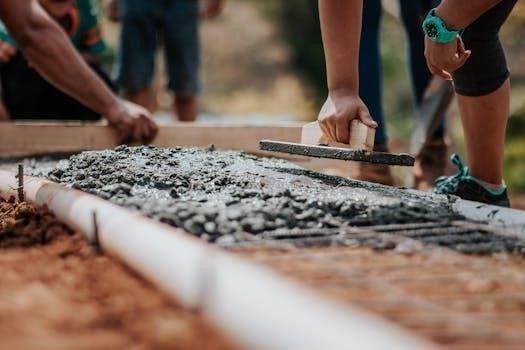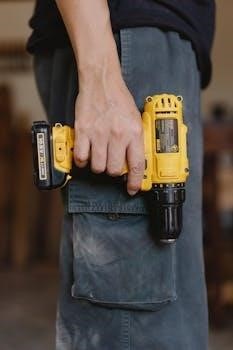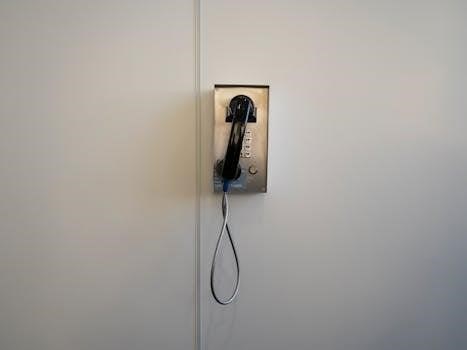ThermoPro TP20 Manual⁚ An Overview
The ThermoPro TP20 is a remote food thermometer with dual probe‚ designed to monitor cooking food temperatures precisely. It ensures perfectly cooked meals with mobility.
Key features include dual-probe technology‚ a wide transmission range (up to 500FT)‚ preset temperature settings‚ and timer functions for optimal cooking control.
The ThermoPro TP20 is a professional-grade remote food thermometer designed to simplify the cooking process and ensure perfectly cooked meals every time. This device is equipped with dual-probe technology‚ allowing users to monitor the temperature of two different food items simultaneously‚ or track the internal temperature of their food alongside the ambient temperature of their grill or oven. With a robust wireless connection‚ the TP20 provides a long-range monitoring capability‚ freeing users from being tethered to the kitchen or grill. Its user-friendly interface‚ combined with preset temperature settings for various types of meat and doneness levels‚ makes it an ideal tool for both novice and experienced cooks. The TP20 promotes convenience and precision‚ ensuring that food is cooked to the desired level of perfection without constant supervision. By offering real-time temperature updates and customizable alarm settings‚ the ThermoPro TP20 empowers users to achieve consistent and delicious results in their culinary endeavors‚ whether grilling outdoors or baking indoors. The inclusion of both a transmitter and a receiver unit further enhances its usability‚ providing a comprehensive solution for temperature monitoring during cooking.
Key Features of the TP20 Thermometer
The ThermoPro TP20 thermometer boasts several key features that make it a standout choice for both amateur and professional cooks. At the forefront is its dual-probe capability‚ which allows users to simultaneously monitor two different food items or track the internal temperature of the food alongside the oven or grill temperature. This feature enhances precision and efficiency in the cooking process. Another significant advantage is its extensive 500FT wireless range‚ offering users the freedom to move around without losing connection to the thermometer. The TP20 also includes pre-programmed temperature settings for various types of meat and doneness levels‚ simplifying the process of achieving perfectly cooked results. Users can customize these settings to their personal preferences‚ further enhancing control over the cooking process. The built-in timer function adds another layer of convenience‚ allowing users to track cooking times and receive alerts when their food is ready. The large‚ backlit LCD screen ensures easy readability‚ even in low-light conditions. The durable construction of the TP20‚ including its stainless steel probes‚ ensures long-lasting performance. Furthermore‚ the TP20 features an alarm system that alerts users when the food reaches the desired temperature‚ preventing overcooking or undercooking. These features combine to make the ThermoPro TP20 a versatile and reliable tool for any cooking enthusiast.

Understanding the TP20’s Components
The receiver unit includes a belt clip for mobility and a display screen showing temperatures. It alerts users when food reaches the desired temperature.
Receiver Features⁚ Belt Clip and Display
The ThermoPro TP20 receiver is designed for user convenience and mobility. Its features include a sturdy belt clip that allows you to attach the receiver to your belt‚ ensuring it’s always within reach as you move around while cooking. This hands-free convenience is particularly useful during barbecues or when managing multiple tasks in the kitchen.
The receiver also boasts a clear and easy-to-read LCD display‚ providing real-time temperature updates from the probes. The display shows temperatures from both probes simultaneously‚ allowing you to monitor two different foods or the internal temperature of your grill or oven alongside the food temperature. The display also features a backlight‚ ensuring visibility even in low-light conditions‚ such as evening cookouts.

Furthermore‚ the receiver includes programmable alarm settings. You can set a target temperature for your food‚ and the receiver will beep and the LCD backlight will illuminate when that temperature is reached. This feature prevents overcooking and ensures your food is cooked to perfection. The receiver also displays the selected meat type and taste level‚ making it easy to monitor your cooking progress accurately. The interface is user-friendly‚ allowing for quick adjustments and easy navigation through the settings.
Transmitter Features⁚ Probe Connections
The ThermoPro TP20 transmitter is designed for reliable and accurate temperature monitoring. A key feature is its dual probe connections‚ allowing you to simultaneously track the temperature of two different food items or monitor both the food’s internal temperature and the ambient temperature inside a grill or smoker. These probe connections are designed to securely hold the stainless-steel probes‚ ensuring continuous and accurate readings during the cooking process.
The transmitter is equipped with clearly marked probe sockets‚ making it easy to insert the probes correctly. These sockets are durable and designed to withstand repeated use‚ ensuring a long-lasting connection. The transmitter also features a power button‚ typically labeled “ºF/ºC‚” which allows you to turn the unit on or off. This button also often serves to switch between Fahrenheit and Celsius temperature readings‚ providing flexibility for different users and recipes.
Additionally‚ the transmitter is designed to be robust and heat-resistant‚ capable of withstanding the high temperatures often encountered in cooking environments. It transmits temperature data wirelessly to the receiver‚ providing real-time updates without the need for direct contact. This wireless functionality allows you to monitor your cooking from a distance‚ giving you freedom and flexibility while ensuring your food is cooked to perfection. The transmitter also houses the battery compartment‚ typically requiring two AAA batteries for operation. The compartment is designed for easy access‚ making battery replacement simple and straightforward.

Operating Instructions
To turn the ThermoPro TP20 on‚ press the power button (usually labeled “ºF/ºC”) on both the transmitter and receiver. To turn them off‚ press and hold the same buttons until the units power down.
Turning the Unit On/Off
To power on the ThermoPro TP20‚ locate the power button on both the transmitter and the receiver units. Typically‚ this button is marked with “ºF/ºC” or a similar temperature unit symbol. Press and briefly hold this button on both devices to switch them on. You should see the LCD screen illuminate‚ indicating that the units are now active and ready for use. Ensure that both the transmitter and receiver are powered on for proper communication and temperature monitoring.
To turn the units off‚ repeat the same process. Press and hold the power button ( “ºF/ºC”) on both the transmitter and the receiver for a few seconds until the LCD screens turn off. This indicates that the units are now powered down. It is essential to switch off both devices when not in use to conserve battery life. Leaving the units on will continue to drain the batteries‚ even if they are not actively monitoring temperatures. Regularly checking and turning off the devices after each use will ensure that the ThermoPro TP20 is always ready for your next cooking session and that you maximize the lifespan of the batteries.
Properly managing the power state of your ThermoPro TP20 will also help prevent any unintended alerts or false readings that might occur if the units are left on accidentally. Getting into the habit of turning off the devices immediately after cooking ensures accurate and reliable performance whenever you need them. Remember to check the battery levels periodically as well‚ replacing them as needed to maintain optimal functionality.
Synchronizing the Transmitter and Receiver
The ThermoPro TP20 typically comes pre-synchronized out of the box‚ but if you experience connectivity issues or have replaced the batteries‚ you may need to re-synchronize the transmitter and receiver. To begin‚ ensure both the transmitter and receiver units are powered on. If the connection is lost‚ the receiver might display a “loss link” alert or show incorrect temperature readings. In such cases‚ re-synchronization is necessary to re-establish the wireless connection.
To synchronize the units‚ first‚ locate the synchronization or “pair” button on both the transmitter and receiver. The location of this button can vary‚ so refer to your user manual for the exact placement. Typically‚ you will need to press and hold this button on both devices simultaneously for a few seconds. The receiver should then display a signal indicating that it is attempting to pair with the transmitter. Keep the units close to each other during this process‚ ideally within a few feet‚ to ensure a strong and stable connection.
Once the synchronization is successful‚ the receiver will display the temperature readings from the transmitter’s probes. If the pairing fails‚ repeat the process‚ ensuring that you are pressing the correct buttons and that the units are close enough to each other. Sometimes‚ external interference can disrupt the synchronization process‚ so try moving away from other electronic devices that might be causing interference. Successful synchronization ensures accurate and reliable temperature monitoring‚ which is crucial for achieving perfectly cooked meals every time.

Troubleshooting Common Issues
Addressing common problems with the ThermoPro TP20‚ such as signal loss‚ range limitations‚ alarm malfunctions‚ and inaccurate temperature readings‚ ensures optimal performance and prolongs the device’s lifespan.
Loss of Signal and Range Problems
Experiencing signal loss or range issues with your ThermoPro TP20 can be frustrating‚ but several factors might be at play. The TP20 boasts a transmission range of up to 500 feet in open areas; however‚ this range can be significantly reduced by obstacles such as walls‚ metal appliances‚ or other electronic devices causing interference. If you notice frequent signal drops‚ try repositioning the transmitter and receiver to minimize obstructions. Ensure the transmitter is not placed inside a closed metal container or directly on a metal surface‚ as this can block the radio frequency signal. Also‚ check the battery levels in both the transmitter and receiver‚ as low batteries can weaken the signal strength. Synchronizing the transmitter and receiver again‚ as outlined in the manual‚ can sometimes resolve connectivity issues. If the problem persists‚ consider testing the thermometer in an open area to determine if environmental factors are the primary cause of the signal loss. Keep the receiver closer to the transmitter to maintain a stable connection. External interference from other devices might also affect the signal‚ so try to minimize other wireless devices nearby when using the TP20. Reviewing the troubleshooting section of the user manual for specific guidance can also provide tailored solutions to your situation. Remember that range can be affected by many factors‚ so a process of elimination can help identify and resolve these common issues.
Alarm Malfunctions and Temperature Readings
If you encounter issues with alarm malfunctions or incorrect temperature readings on your ThermoPro TP20‚ several steps can help resolve these problems. First‚ ensure that the high and low temperature settings are correctly programmed according to your desired cooking parameters. Double-check that the alarm function is activated‚ as it can sometimes be inadvertently turned off. If the alarm sounds prematurely or not at all‚ verify that the probe is securely inserted into the meat and properly connected to the transmitter. An improperly connected or damaged probe can lead to inaccurate temperature readings and trigger false alarms. Inspect the probe wires for any signs of damage‚ such as kinks or fraying‚ which can affect their performance. If using dual probes‚ make sure each probe is assigned to the correct channel on the receiver. For inaccurate temperature readings‚ calibrate the thermometer following the instructions in the manual. Extreme temperatures or prolonged exposure to heat can sometimes affect the probe’s accuracy. Clean the probes thoroughly after each use to remove any residue that might interfere with temperature sensing. If the issue persists‚ try replacing the batteries in both the transmitter and receiver‚ as low battery power can cause erratic behavior. Review the user manual for detailed troubleshooting steps specific to alarm and temperature reading issues. If none of these steps resolve the problem‚ contact ThermoPro customer service for further assistance‚ as there might be a defect requiring professional attention. Regularly maintaining and checking the probes ensures accurate and reliable performance.















